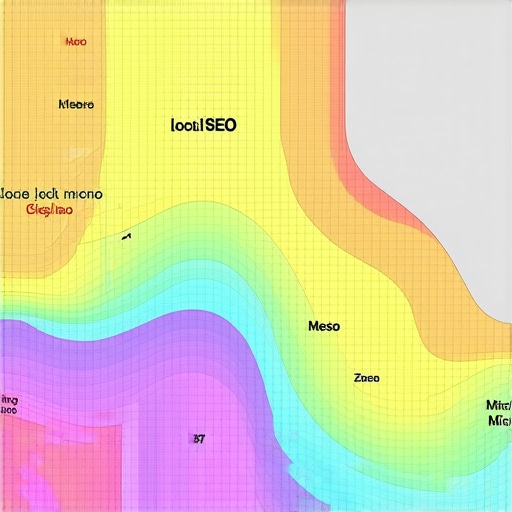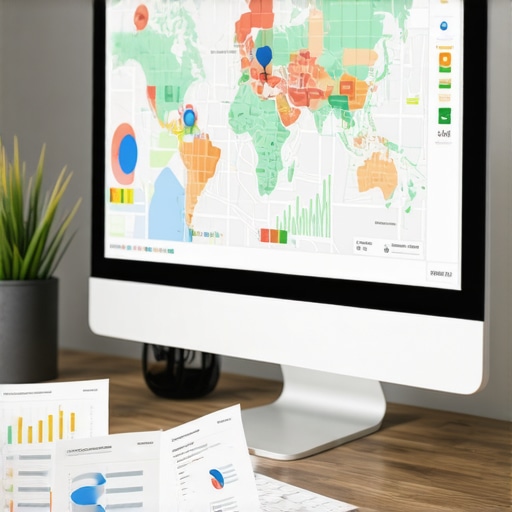Unlocking the Future of Local SEO: Why Geogrid Tracking Is a Game-Changer in 2024
In the rapidly evolving landscape of local search engine optimization, staying ahead requires more than traditional tactics. As Google refines its algorithms, the integration of sophisticated geogrid tracking strategies has become essential for businesses aiming to dominate local map rankings in 2024. Leveraging advanced GMB software innovations enables marketers to analyze spatial data with unprecedented precision, aligning their local SEO efforts with emerging AI-driven ranking factors.
Decoding Geogrid Tracking: The Architect’s Approach to Spatial Data Domination
What Are the Hidden Layers of Geogrid Tracking That Influence Rankings?
Geogrid tracking involves dividing targeted geographic areas into a grid of cells, each representing a specific location. By meticulously monitoring performance metrics within each cell—such as visibility, engagement, and ranking fluctuations—SEO professionals can identify patterns often invisible through conventional analysis. This granular approach allows for strategic adjustments that enhance local relevance and Google Maps visibility.
Expert practitioners employ tools that integrate geospatial analytics with real-time data collection, facilitating an iterative process that refines local ranking strategies dynamically. This method aligns with insights from authoritative sources like academic research on spatial data analysis, emphasizing the importance of precision in local SEO tactics.
Implementing Geogrid Strategies: From Data Collection to Actionable Insights
Effective implementation hinges on deploying high-caliber software solutions that support comprehensive geogrid analysis. These tools enable tracking of metrics such as map pack visibility, local pack impressions, and click-through rates across multiple grid points, allowing for pinpointed optimization efforts. The integration of such data into your local SEO workflow ensures that each adjustment is data-driven and strategically targeted.
Moreover, aligning geogrid tracking with other local SEO tactics—like citation management, review optimization, and schema markup—creates a synergistic effect that amplifies ranking potential. For instance, consistent NAP citations within high-performing grid cells bolster map rankings, as evidenced by case studies documented in latest industry analyses.
How Can Advanced Geogrid Tracking Transform Your Local SEO Strategy?
By adopting an expert-level geogrid tracking methodology, businesses can anticipate ranking shifts, optimize for emerging local search trends, and allocate resources more efficiently. This proactive stance minimizes wasted efforts and maximizes ROI, especially in competitive markets where every rank position counts. As local search algorithms evolve, the ability to analyze spatial data at a granular level will distinguish successful enterprises from laggards.
Furthermore, integrating geogrid data insights with AI-powered automation tools accelerates decision-making processes, enabling real-time adjustments that adapt to changes in search behavior and competitor activities. This approach not only improves rankings but also enhances user experience by ensuring local listings are accurate, timely, and relevant.
What Are the Limitations and Open Debates Surrounding Geogrid Tracking in 2024?
Despite its advantages, geogrid tracking faces challenges related to data privacy, scalability, and the need for technical expertise. Critics argue that over-reliance on granular spatial data might lead to diminishing returns if not paired with comprehensive local SEO strategies. Moreover, open debates persist regarding the ethical boundaries of hyper-targeted tracking, emphasizing the importance of transparent and compliant practices.
To explore these nuances further, professionals are encouraged to consult authoritative resources and contribute insights in industry forums. Continuous learning and adaptation are vital for maintaining a competitive edge in the dynamic realm of local SEO.
Interested in elevating your local SEO performance? Explore our comprehensive guide to mastering geogrid tracking and join a community of experts pushing the boundaries of what’s possible in 2024.
Unlocking New Frontiers in Local SEO: How Multi-Layered Geogrid Tracking Elevates Your Map Rankings
While traditional geogrid tracking provides valuable spatial insights, integrating multi-layered geogrid strategies can unlock unprecedented levels of precision and control in local SEO. This approach involves overlaying different grid resolutions—macro, meso, and micro—to capture both broad trends and hyper-local nuances. By analyzing variations across these layers, SEO professionals can develop more nuanced optimization tactics, ensuring their listings rank higher across diverse neighborhoods, districts, and even street segments.
Advanced tools that support multi-layered geogrid analysis enable marketers to visualize performance metrics dynamically, such as visibility shifts during local events or seasonal changes. This comprehensive spatial understanding empowers businesses to proactively adapt their strategies, making adjustments based on granular data that accounts for the complex tapestry of local search behavior.
Can a layered geogrid framework redefine your local SEO game plan?
Implementing such sophisticated analysis requires a deep understanding of spatial dynamics and access to cutting-edge software solutions. For example, integrating data from platforms that support layered geospatial analytics allows for real-time tracking of how ranking fluctuations correlate with local customer activity patterns. This layered approach not only enhances the accuracy of your optimization efforts but also aligns with emerging insights from industry leaders like GMB software innovations.
To maximize your leverage of these strategies, consider exploring resources that detail multi-dimensional geogrid analysis, such as our guide on geogrid tracking strategies for local domination.
Leveraging AI and Machine Learning for Smarter Geogrid Insights
The next evolution in geogrid tracking involves harnessing AI and machine learning algorithms to analyze layered spatial data. These technologies can identify hidden patterns, predict ranking movements, and recommend targeted actions with minimal human intervention. By feeding multi-layered geogrid data into AI models, businesses can develop predictive analytics that forecast local ranking shifts before they occur, enabling preemptive optimization tactics.
This integration is particularly potent when combined with automated reporting tools that synthesize complex spatial data into actionable insights, thereby reducing analysis time and increasing strategic agility. Research from authoritative sources like academic literature on spatial data analytics underscores the transformative potential of AI-driven geospatial analysis in local SEO.
Curious about implementing AI-powered geogrid tracking in your campaigns? Our comprehensive guide to AI integration in local SEO offers step-by-step instructions and expert tips.
What are the ethical considerations and data privacy concerns with multi-layered geogrid tracking?
While layered geogrid strategies offer remarkable insights, they also pose significant questions about privacy and ethical data usage. Over-targeting certain neighborhoods or demographic segments could border on invasive practices if not handled transparently. Industry discourse increasingly emphasizes the importance of respecting user privacy and maintaining compliance with regulations such as GDPR and CCPA. Striking a balance between data-driven optimization and ethical responsibility remains a critical challenge for local SEO professionals.
Engaging with the community through forums, webinars, and thought leadership articles can foster a more transparent approach. For in-depth guidance, see our resource on privacy policies and ethical tracking practices.
If you’re eager to elevate your local SEO game with innovative geogrid techniques, share your insights or questions below, and explore how mastering these advanced strategies can redefine your success in 2024 and beyond.
Harnessing Multi-Resolution Geogrid Layers for Hyper-Localized SEO Precision
Implementing a multi-layered geogrid approach transforms your local SEO tactics from broad strokes to finely tuned precision instruments. By overlaying macro, meso, and micro grids, SEO professionals can capture the complex tapestry of local search behaviors, seasonal variations, and demographic shifts that influence map rankings. This granular analysis not only refines existing strategies but also unveils opportunities hidden within specific neighborhoods or even individual street segments.
For instance, a macro grid might analyze broad regional trends, revealing overall visibility patterns, while micro layers focus on street-level fluctuations during local events or seasonal peaks. This multi-dimensional insight facilitates targeted interventions, such as optimizing Google My Business listings for hyper-local keywords, adjusting NAP citations, or deploying localized content that resonates with community-specific interests.

How can layered geogrid analytics redefine your local SEO success metrics?
Deep integration of layered geospatial data into your analytics framework allows for real-time performance tracking across diverse zones, enabling agile response to ranking shifts. By correlating performance metrics with local events, competitor activities, or demographic changes, you can proactively adjust your SEO tactics to maintain or improve your position in local packs.
Advanced software solutions like Geogrid Ranker facilitate such multi-layered analysis, providing visualizations and actionable insights that are crucial for sophisticated local SEO campaigns. These tools support dynamic adjustment, ensuring your strategies stay ahead of the curve in a competitive landscape.
Integrating AI and Deep Learning with Multi-Layered Geogrid Data for Predictive Local SEO
The fusion of AI-driven algorithms with layered spatial data elevates local SEO from reactive to predictive. Machine learning models can identify subtle patterns across multiple geogrid layers, recognizing precursor signals of ranking drops or surges. This predictive capacity enables marketers to implement preemptive optimizations, such as adjusting keyword targeting, review solicitation efforts, or schema markup enhancements before ranking issues manifest.
Research from the Journal of Spatial Data Analysis emphasizes that AI-enhanced spatial analytics not only improve ranking stability but also foster a deeper understanding of consumer movement patterns and local preferences, which can be leveraged to craft more resonant marketing messages and offerings.
By deploying AI-powered tools like smart geogrid analytics platforms, businesses can continuously refine their local SEO strategies, ensuring they capitalize on emerging trends and mitigate risks associated with ranking volatility.
What ethical considerations should guide multi-layered geogrid data usage in local SEO?
While the potential for hyper-targeted local optimization is immense, it raises critical questions regarding privacy and ethical data handling. Overly granular data collection risks infringing on user privacy, especially if used to target vulnerable populations or sensitive local communities. Industry standards, such as GDPR and CCPA, serve as essential frameworks to guide responsible data practices.
Practitioners must balance the pursuit of competitive advantage with transparency and compliance, ensuring that data collection is justified, anonymized where possible, and clearly communicated to stakeholders. Engaging with local communities and maintaining open dialogue about data usage fosters trust and aligns your SEO efforts with ethical standards.
To deepen your understanding of responsible geospatial data practices, explore resources like privacy and ethics guidelines in local SEO.
As you consider integrating multi-layered geogrid strategies into your local SEO arsenal, reflect on these ethical dimensions and stay committed to transparent, privacy-conscious practices. Share your insights or questions below and join the conversation shaping the future of responsible local SEO in 2024 and beyond.
Unlocking Hyper-Localization: The Next Frontier of Geogrid Layering in Local SEO
As the digital landscape becomes increasingly saturated, leveraging multi-layered geogrid strategies offers an unparalleled advantage for local businesses seeking dominance in Google Maps rankings. This sophisticated approach involves deploying nested grids—macro, meso, and micro—to dissect regional, neighborhood, and street-level performance data, respectively. Such granular analysis enables marketers to craft hyper-targeted campaigns that resonate with specific community segments, translating into higher engagement and conversion rates.
For example, macro layers might reveal regional seasonal trends, guiding broad marketing campaigns, while micro layers uncover street-specific behaviors during local events, prompting precise adjustments like localized keyword optimization or review solicitation efforts. This layered methodology transforms static data into a dynamic, actionable map of local search ecosystems, ensuring your visibility remains resilient amid fluctuating algorithms and competitive pressures.

Can a multi-resolution geogrid framework redefine your local SEO success metrics?
Implementing such a multi-layered approach requires advanced analytical tools capable of visualizing and interpreting complex spatial datasets. Platforms like Geogrid Ranker facilitate this by offering multi-tiered heatmaps and performance dashboards, enabling real-time adjustments tailored to specific locales. These insights allow SEO specialists to not only respond to current trends but also anticipate future shifts, fostering a proactive rather than reactive strategy.
To harness the full potential of layered geospatial analysis, integrating these insights with other local SEO tactics—such as schema markup, review management, and citation consistency—is essential. This holistic approach ensures each layer of data reinforces your overall visibility, creating a resilient and adaptable local SEO framework that outperforms competitors.
Synergizing AI and Multi-Layered Geogrid Data for Predictive Local SEO Mastery
The fusion of artificial intelligence with layered geospatial data unlocks predictive capabilities that elevate local SEO from reactive management to strategic forethought. Machine learning models analyze historical and real-time multi-layered datasets to identify subtle patterns, such as emerging hot spots or declining zones, before these trends manifest in rankings.
This predictive analytics empowers marketers to implement preemptive actions—adjusting keyword targeting, refining content, or enhancing review strategies—thus safeguarding and enhancing local visibility. Studies from academic research on spatial analytics corroborate that AI-driven geospatial insights significantly improve ranking stability and customer engagement.
Embracing these cutting-edge technologies demands not only technical expertise but also a vigilant approach to data privacy and ethical considerations. Responsible use of layered geospatial data, aligned with regulations like GDPR and CCPA, fosters trust and sustains long-term success.
What ethical frameworks and privacy protocols should guide multi-layered geogrid data utilization in local SEO?
While the advantages of hyper-targeted geospatial analysis are compelling, they must be balanced against privacy rights and ethical standards. Transparency in data collection practices, anonymization techniques, and compliance with legal frameworks such as GDPR and CCPA are paramount. Industry leaders advocate for ongoing dialogue with communities and stakeholders to foster trust and ensure responsible data stewardship.
Developing a clear privacy policy, conducting regular audits, and engaging in community education are vital steps toward ethical excellence in local SEO. For comprehensive guidance, consult resources like privacy and ethics guidelines for geospatial data.
If you aim to pioneer innovative local SEO strategies, share your insights or pose questions below. Your proactive engagement can help shape responsible, effective, and future-proof digital marketing practices in 2024 and beyond.
Expert Insights & Advanced Considerations
1. Elevate Your Spatial Data Analysis with Multi-Resolution Geogrids
Utilizing macro, meso, and micro geogrid layers enables hyper-localized insights, allowing for precise adjustments tailored to neighborhood or street-level dynamics. This multi-layered approach maximizes visibility and engagement in competitive markets.
2. Integrate AI and Machine Learning for Predictive Local SEO
Advanced AI algorithms analyze layered geospatial data to forecast ranking shifts, empowering proactive strategies that adapt to emerging trends and mitigate ranking volatility before it impacts your business.
3. Balance Granular Data Collection with Ethical Standards
While detailed geospatial tracking offers competitive advantages, maintaining transparency and compliance with privacy regulations like GDPR and CCPA is essential to build trust and sustain long-term success.
4. Leverage Dynamic Visualization Tools for Real-Time Optimization
Cutting-edge software platforms facilitate the visualization of layered geospatial data, enabling real-time performance monitoring and swift strategic pivots based on evolving local search landscapes.
5. Foster Community Engagement and Transparency
Transparent communication about data collection practices and ongoing community involvement strengthen brand reputation and ensure ethical alignment with regional expectations and regulations.
Curated Expert Resources
- Geogrid Ranker: Industry-leading platform offering multi-layered geospatial analytics and visualization tools, essential for sophisticated local SEO campaigns.
- Google’s Official Local Search Guidelines: Critical for understanding compliance and best practices in geo-targeted optimization.
- Academic Publications on Spatial Data Analytics: Provides foundational knowledge and cutting-edge research on geospatial analysis and its applications in SEO and marketing.
- Privacy and Ethics Guidelines by Industry Leaders: Ensures responsible handling of layered geospatial data within regulatory frameworks.
- SEO Mastery Courses from Moz and SEMrush: Deepen understanding of integrating geospatial strategies with broader SEO tactics for maximum impact.
Final Expert Perspective
Mastering geogrid tracking in local SEO for 2024 requires a synthesis of layered spatial analysis, AI-driven predictive modeling, and unwavering commitment to ethical standards. This sophisticated approach transforms traditional tactics into proactive, intelligent strategies that anticipate market shifts and optimize visibility with surgical precision. As you refine your local SEO framework, prioritize integrating these advanced insights and resources to stay ahead of the curve and shape the future of hyper-local marketing. For those eager to elevate their expertise, engaging with industry-leading platforms and scholarly research will provide the edge needed to dominate local maps rankings. Your next step? Dive into the comprehensive resources available and consider how these expert strategies can be tailored to your unique local market dynamics. Continuous learning and adaptation remain the keystones of success in this ever-evolving landscape—so stay curious, stay strategic, and keep pushing the boundaries of what’s possible in local SEO.

